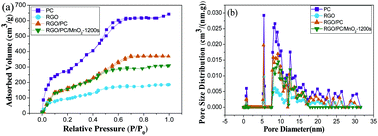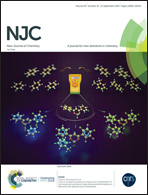A ternary MnO2-deposited RGO/lignin-based porous carbon composite electrode for flexible supercapacitor applications
Abstract
MnO2 nanoparticles with high theoretical capacitance were successfully synthesized on a reduced graphene oxide/lignin-based porous carbon (RGO/PC) composite membrane by a simple electrodeposition method, and a ternary RGO/PC/MnO2 composite electrode for flexible supercapacitors was prepared. The RGO/PC/MnO2-1200s composite electrode exhibited a maximum specific capacitance of 1136 mF cm−2 (MnO2 mass loading of 6.25 mg cm−2 and a mass specific capacitance of 135 F g−1) at a current density of 1 mA cm−2. This is attributed to the high surface area of the MnO2 nanoparticles and the conductive pathway provided by the RGO/PC framework. The assembled flexible solid-state symmetric supercapacitors have outstanding cycling stability (approximately 85.2% capacitance retention after 5000 cycles) and good mechanical flexibility (about 87.6% of the original capacitance after 500 bending cycles). Importantly, the device can possess a maximum energy density of 0.253 mW h cm−3 at 0.5 mA cm−2 and a maximum power density of 0.018 W cm−3 at 5 mA cm−2. The results above indicate that the RGO/PC/MnO2 composite has potential applications in flexible energy storage devices.



 Please wait while we load your content...
Please wait while we load your content...